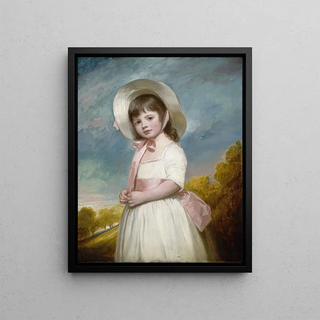Art print | Mademoiselle Juliana Willoughby - George Romney Source: Reproduction | Mademoiselle Juliana Willoughby - George Romney


View from behind

Frame (optional)
In the fascinating world of art, some works stand out for their ability to capture the essence of an era while revealing the depth of human emotions. "Mademoiselle Juliana Willoughby" by George Romney is one of those creations that transcend the simple act of painting. This piece, through its elegance and sophistication, invites the viewer to immerse themselves in the 18th century, where fashion, beauty, and social status intertwine gracefully. The depiction of Juliana Willoughby, with her penetrating gaze and poised attitude, evokes a rich and intriguing story, that of a woman of great distinction, whose portrait has become emblematic of a bygone era.
Style and uniqueness of the work
George Romney's style is characterized by unmatched finesse and meticulous attention to detail. In "Mademoiselle Juliana Willoughby," the chiaroscuro technique is masterfully employed to highlight the delicate features of his model's face. The subtle nuances of color, ranging from warm tones to soft shadows, create an atmosphere of serenity and mystery. Every brushstroke seems charged with emotion, making Juliana's figure almost alive. Her richly adorned attire reflects the fashion of the time, while the overall composition exudes harmony that draws the eye and captivates the mind. This piece does not merely depict a person; it tells a story, that of a life full of promises and dreams.
The artist and his influence
George Romney, born in 1734, is one of the most renowned portraitists of his time. His work is marked by a constant pursuit of beauty and individual expression, which allowed him to establish a prominent place in the world of British art. Influenced by the great masters of painting, he developed a style that is uniquely his own, combining elegance and sensitivity. His approach to portraiture, which emphasizes the psychology of his subjects, paved the way for many artists who followed him. By painting iconic figures of his society, Romney not only immortalized

Matte finish

View from behind

Frame (optional)
In the fascinating world of art, some works stand out for their ability to capture the essence of an era while revealing the depth of human emotions. "Mademoiselle Juliana Willoughby" by George Romney is one of those creations that transcend the simple act of painting. This piece, through its elegance and sophistication, invites the viewer to immerse themselves in the 18th century, where fashion, beauty, and social status intertwine gracefully. The depiction of Juliana Willoughby, with her penetrating gaze and poised attitude, evokes a rich and intriguing story, that of a woman of great distinction, whose portrait has become emblematic of a bygone era.
Style and uniqueness of the work
George Romney's style is characterized by unmatched finesse and meticulous attention to detail. In "Mademoiselle Juliana Willoughby," the chiaroscuro technique is masterfully employed to highlight the delicate features of his model's face. The subtle nuances of color, ranging from warm tones to soft shadows, create an atmosphere of serenity and mystery. Every brushstroke seems charged with emotion, making Juliana's figure almost alive. Her richly adorned attire reflects the fashion of the time, while the overall composition exudes harmony that draws the eye and captivates the mind. This piece does not merely depict a person; it tells a story, that of a life full of promises and dreams.
The artist and his influence
George Romney, born in 1734, is one of the most renowned portraitists of his time. His work is marked by a constant pursuit of beauty and individual expression, which allowed him to establish a prominent place in the world of British art. Influenced by the great masters of painting, he developed a style that is uniquely his own, combining elegance and sensitivity. His approach to portraiture, which emphasizes the psychology of his subjects, paved the way for many artists who followed him. By painting iconic figures of his society, Romney not only immortalized






